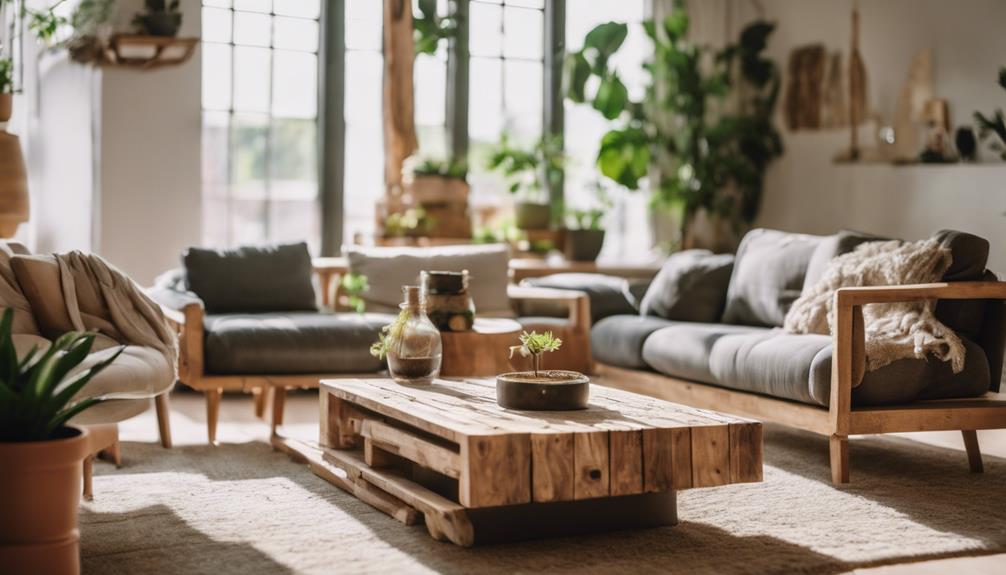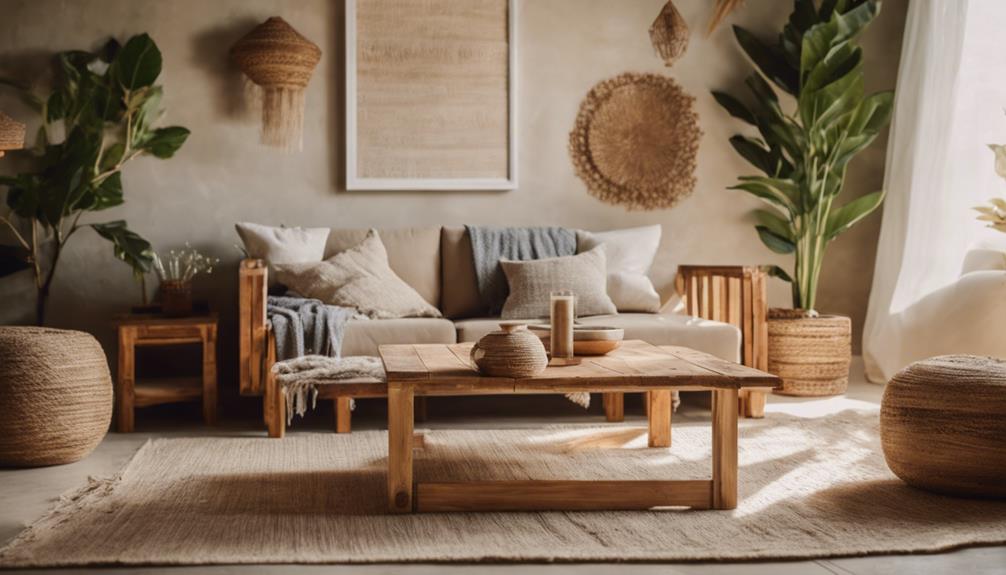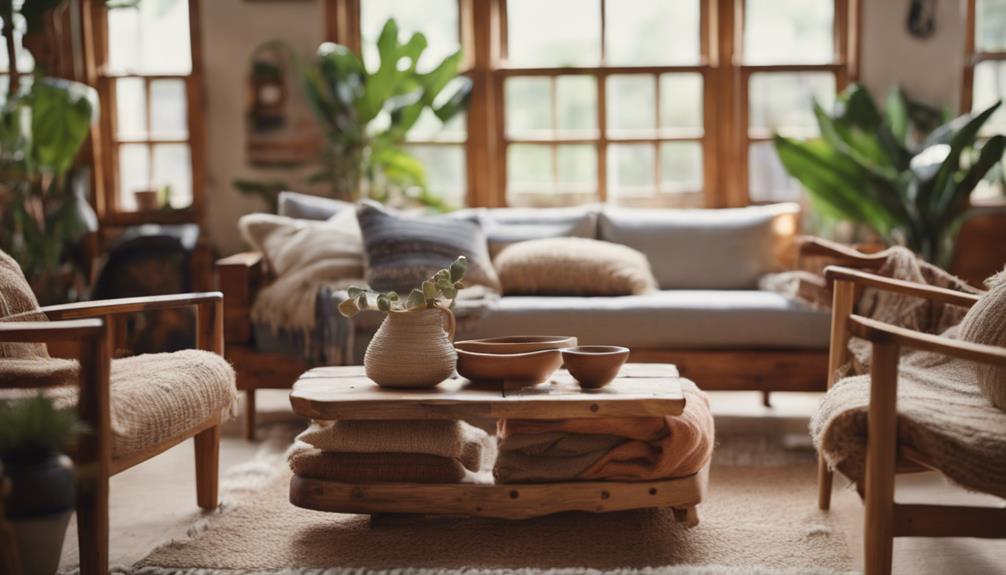Sustainable home decor involves utilizing materials and practices that minimize harm to the environment. It enhances the quality of your living space, reduces carbon emissions, and betters air quality. By selecting eco-friendly materials, you can reduce your environmental footprint, support ethical production methods, and preserve resources. Opting for locally sourced decor not only contributes to communities but also ensures authenticity. Non-toxic materials protect the health and well-being of individuals of all ages. Upcycling creatively transforms old items into new pieces, promoting sustainability and individuality. Choosing sustainable decor allows you to make mindful decisions that benefit both your home and the planet. Discover more information by exploring further.
Key Takeaways
- Enhances living environment and promotes health.
- Reduces carbon emissions and minimizes harm to the planet.
- Improves air quality and supports ethical production practices.
- Uses eco-friendly materials to reduce environmental impact.
- Includes upcycled decor for unique, sustainable design.
Importance of Sustainable Decor

Choosing sustainable decor enhances your living environment by promoting health and well-being through eco-friendly materials and practices. The environmental impact of sustainable decor is significant, as it helps reduce carbon emissions and minimizes harm to the planet.
By opting for eco-friendly options, you contribute to a healthier indoor environment with improved air quality. Traditional home decor often contains harmful chemicals that can negatively affect your health and well-being. In contrast, sustainable decor focuses on using non-toxic materials that enhance air quality and create a safer space for you and your family.
This emphasis on eco-friendly practices not only benefits your immediate surroundings but also supports a larger movement towards sustainable living. Making sustainable decor choices is a proactive step towards improving your quality of life and reducing your carbon footprint. By prioritizing eco-friendly materials, you're investing in a healthier future for yourself and the environment.
Benefits of Eco-Friendly Materials

Utilizing eco-friendly materials in sustainable home decor offers numerous advantages that extend beyond just environmental benefits. By choosing materials such as renewable, nontoxic, and recycled components, you can greatly reduce the environmental impact of your decor choices. These eco-friendly materials play an essential role in promoting healthier indoor air quality by avoiding harmful chemicals and volatile organic compounds (VOCs), creating a safer environment for you and your loved ones.
Sustainable materials like FSC-certified wood, organic textiles, and recycled glass not only help conserve natural resources but also encourage responsible sourcing practices. Additionally, opting for these materials supports ethical production practices, ensuring fair wages and safe working conditions for workers throughout the entire supply chain.
Ethical Production Practices

Adopting ethical production practices guarantees a sustainable and responsible approach to creating home decor items. By ensuring fair wages, supporting artisan training, and using recycled materials like metals, brands like ONEOFEACH, Eugenia, and Adele Dejak exemplify the essence of ethical production. These practices not only benefit the environment but also uplift communities and promote social responsibility. Little Pine Tree and Tekura showcase how ethical production can extend to children's toys and wood products, demonstrating a holistic commitment to sustainability. Embracing these principles fosters a conscious consumer culture where the impact of each purchase goes beyond aesthetics, contributing to a better world for all. Below is a table summarizing the ethical production practices of these innovative brands:
| Brand | Ethical Practices | Materials |
|---|---|---|
| ONEOFEACH | Fair wages, artisan training | Ethically sourced |
| Eugenia | Fair wages, sustainably paid farmers | Quality shea butter |
| Adele Dejak | Recycled metals | Sustainable |
| Little Pine Tree | Ethical production practices | Non-toxic |
| Tekura | Upcycled wood offcuts, sustainable production methods | Reforested wood |
Local Sourcing for Home Decor

Sourcing materials locally for your home decor supports the community, reduces environmental impact, and guarantees authenticity and quality. When you opt for local sourcing, you contribute to the sustainability of your surroundings by supporting the local economy and promoting sustainable practices. By obtaining materials from nearby suppliers or artisans, you not only reduce transportation emissions but also make sure that your home decor items are ethically produced.
Moreover, choosing locally sourced home decor allows you to connect with the makers, understand the production process, and appreciate the craftsmanship behind each piece. This connection adds a unique touch to your living space, creating a sense of place and individuality. Supporting local artisans and businesses through local sourcing not only benefits you but also helps maintain the cultural and artistic heritage of your community. Embrace local sourcing for your home decor to make a positive impact on both your space and the local economy.
Impact of Non-Toxic Materials

When you choose non-toxic materials for your home decor, you're safeguarding your health by reducing indoor air pollution.
These materials also contribute to a healthier living environment, especially for families with young children or pets.
Opting for non-toxic decor items not only supports your well-being but also helps in minimizing environmental impact.
Health Benefits of Non-Toxic Materials
By prioritizing non-toxic materials in your sustainable home decor choices, you can greatly enhance the health and well-being of your indoor environment. Non-toxic materials play an important role in reducing indoor air pollution by limiting harmful chemicals like VOCs. Opting for these materials promotes better respiratory health, lowering the risk of allergies and respiratory issues.
Sustainable home decor made from non-toxic components creates a healthier indoor environment for you and your family. Items like furniture and textiles, when crafted from non-toxic materials, support overall well-being by minimizing exposure to harmful substances. Choosing non-toxic options aligns with eco-friendly practices, fostering a safer and more sustainable living environment for everyone in your household.
Environmental Impact Reduction
Reducing the environmental impact through the use of non-toxic materials in sustainable home decor is an essential step towards creating a healthier living space. By opting for VOC-free materials, you can decrease indoor air pollution and lower your carbon footprint. These materials help in reducing harmful emissions such as carbon dioxide, thereby contributing to a healthier environment.
Choosing sustainable fabrics, like OEKO-TEX STANDARD 100 certified textiles, guarantees minimal chemical exposure and supports ethical production practices. Additionally, selecting decor items with ECOLOGO® Certification signifies a reduced environmental impact, making them a more eco-conscious choice.
Sustainable forestry certifications, such as SFI and FSC, ensure responsible wood sourcing, protecting forests and biodiversity. Incorporating these non-toxic materials into your decor helps in conserving energy sources and promoting a greener lifestyle.
Safety for All Ages
Using non-toxic materials in sustainable home decor promotes safety for all ages by minimizing exposure to harmful chemicals and fostering a healthier indoor environment. Opting for decor items made from non-toxic materials not only reduces the risk of health issues but also contributes to improved air quality within your living space.
By choosing products with VOC-free components, you can create a safer and healthier environment for you and your family. Embracing non-toxic materials in your home decor supports a sustainable lifestyle while minimizing the environmental impact.
Look for certifications like OEKO-TEX STANDARD 100 to make sure that the decor items you bring into your home adhere to strict safety and health standards, providing peace of mind for you and your loved ones.
Upcycling in Home Decor

When it comes to upcycling in home decor, you'll discover a world of creative possibilities. By repurposing discarded items, you can breathe new life into your living space while reducing waste.
From furniture made of reclaimed wood to unique accessories crafted from recycled materials, the benefits of upcycling in home decor are endless.
Creative Upcycling Ideas
Repurposing old or discarded items creatively into new and functional pieces is a hallmark of upcycling in home decor. By using repurposed materials, upcycling promotes sustainability by giving a new lease of life to items that might've ended up in landfills.
Creative upcycling ideas can add a unique and personalized touch to your living space. For instance, you can turn old pallets into a rustic coffee table or transform glass jars into stylish storage containers. Engaging in upcycling encourages creativity, resourcefulness, and eco-consciousness in decorating your home.
These ideas not only help reduce waste but also showcase your ability to think outside the box and contribute to a more sustainable lifestyle.
Benefits of Upcycling
To truly appreciate the value of upcycling in home decor, consider the positive impact it has on both your living space and the environment. Upcycling involves repurposing old materials into new items, reducing waste and promoting sustainable home decor.
By upcycling, you help decrease the demand for new raw materials, conserving natural resources and lowering energy consumption during production. Upcycled home decor pieces often boast unique designs, adding character to your living space.
Additionally, upcycling contributes to a circular economy by extending product lifespans and minimizing landfill waste. Engaging in upcycling fosters creativity and innovation, encouraging you to think creatively and find new uses for items that would have otherwise been discarded.
Embrace upcycling for a more sustainable and environmentally friendly home decor approach.
Upcycled Decor Examples
Consider incorporating upcycled decor examples into your home to embrace sustainable and eco-friendly design practices. Recycled materials are commonly used in sustainable home decor products, like those offered at 54kibo. Designer Candice Lawrence repurposes wood offcuts to craft smaller upcycled items, while Tekura sources wood offcuts from reforested wood in Ghana for their eco-friendly decor pieces.
Kenyan jewelry designer Adele Dejak incorporates recycled metals in creating unique upcycled jewelry. Upcycled home decor items often feature sustainable practices such as using eco-friendly varnish and employing flat-packed designs. By choosing upcycled decor, you not only add a touch of creativity to your space but also contribute to the conservation of resources and the reduction of waste.
Creating Stylish Eco-Conscious Spaces

Embracing sustainability in your home decor choices can transform your living spaces into stylish and eco-conscious sanctuaries. By opting for eco-friendly materials like reclaimed wood, bamboo, and recycled textiles, you can reduce your environmental impact while adding a touch of natural beauty to your home. Choosing furniture and decor made from these sustainable materials not only enhances the aesthetics of your space but also supports ethical production practices.
In addition to eco-friendly materials, incorporating energy-efficient lighting can further enhance the sustainability of your home decor. Energy-efficient lighting not only saves electricity but also creates a warm and inviting ambiance in your living spaces. By using LED bulbs and fixtures, you can reduce your carbon footprint and contribute to a more eco-friendly lifestyle. Moreover, adding indoor plants and water-saving fixtures can promote a healthier indoor environment while enhancing the overall sustainability of your home decor choices.
Supporting Artisans in Home Decor

Supporting artisans in home decor elevates the authenticity and ethical value of your living space while honoring traditional craftsmanship. By opting for artisan-made sustainable home decor products, you're actively supporting ethically produced items and contributing to the preservation of traditional techniques.
When you purchase these pieces, you not only bring unique designs and cultural influences into your home but also help sustain the livelihoods of skilled craftsmen and women. Additionally, choosing artisan-made home decor adds a personal touch to your space, reflecting your appreciation for handcrafted items and making a positive impact on global artisans and communities.
Through this conscious decision, you promote fair wages, ethical production practices, and the preservation of cultural heritage within the home decor industry. Embrace the beauty of traditional craftsmanship while enhancing the aesthetic appeal of your living environment with artisan-made home decor pieces.
Reducing Environmental Footprint

To minimize your environmental impact through sustainable home decor, prioritize the use of eco-friendly materials and energy-efficient solutions.
Opt for decor items made from recycled materials, such as reclaimed wood, to reduce your carbon footprint and lessen harm to the environment. Choosing non-toxic components and VOC-free materials for your decor not only contributes to a healthier indoor environment but also supports sustainable practices.
Look for certifications like SFI and FSC to make sure that the decor products you purchase are responsibly sourced and align with sustainable forestry practices. Additionally, incorporating energy-efficient appliances and lighting into your home decor can greatly decrease energy consumption, further reducing your environmental impact.
Community Empowerment Through Decor

By incorporating ethically produced decor items, you can actively contribute to empowering communities and supporting sustainable development. Brands like ONEOFEACH provide fair wages and skills training, fostering community development through their ethical production practices.
Local sourcing of materials in sustainable decor not only promotes economic growth but also contributes to long-term sustainability by supporting local businesses. Collaborating with sustainably paid farmers, such as with Eugenia's shea butter, uplifts communities by ensuring a fair income for producers.
Additionally, initiatives like Little Pine Tree, which empower women through craft and skills training, play a significant role in enhancing social equity within communities. When you choose sustainable home decor that values community empowerment, you not only bring unique and ethical pieces into your space but also become a part of a larger movement towards supporting fair labor practices and local development.
Your choices in decor can have a meaningful impact on communities worldwide, making a difference one purchase at a time.
Frequently Asked Questions
How to Decorate Your Home Sustainably?
To decorate your home sustainably, consider the following steps:
Choose furniture made from reclaimed wood or bamboo.
Use energy-efficient LED and CFL bulbs for lighting.
Incorporate houseplants for better air quality.
Consider solar energy to reduce fossil fuel reliance.
Buy locally made decor to support the economy and lessen transportation emissions.
These steps can help lower your environmental impact while creating a stylish and eco-friendly living space.
What Is Sustainable Home Design?
Sustainable home design prioritizes eco-friendly materials and energy-efficient practices to reduce environmental impact. Incorporating elements like energy-efficient lighting, water-saving fixtures, and indoor plants creates a healthier living space.
How to Choose Sustainable Home Decor?
When choosing sustainable home decor, look for certifications like SFI and FSC for forestry, opt for non-toxic, VOC-free materials, and products with reduced carbon footprint certified by ECOLOGO®.
Choose items made from sustainable fabrics like OEKO-TEX STANDARD 100 textiles. Support ethical production by selecting companies that prioritize fair wages and safe working conditions.
What Does "Sustainable" Mean in a House?
When it comes to your house, being sustainable means making choices that are eco-friendly and reduce your impact on the environment.
From using renewable materials to energy-efficient fixtures, every decision you make can contribute to a greener home.
Consider the lifecycle of products, opt for natural and non-toxic materials, and support fair trade practices.
Conclusion
To sum up, sustainable home decor is more than just a trend – it's a conscious choice to protect our planet and support ethical practices.
By opting for eco-friendly materials, ethical production practices, and supporting local artisans, you can create stylish and eco-conscious spaces that reduce your environmental footprint.
So, why not take the step towards a more sustainable future and transform your home into a sanctuary that not only looks good but does good too?









